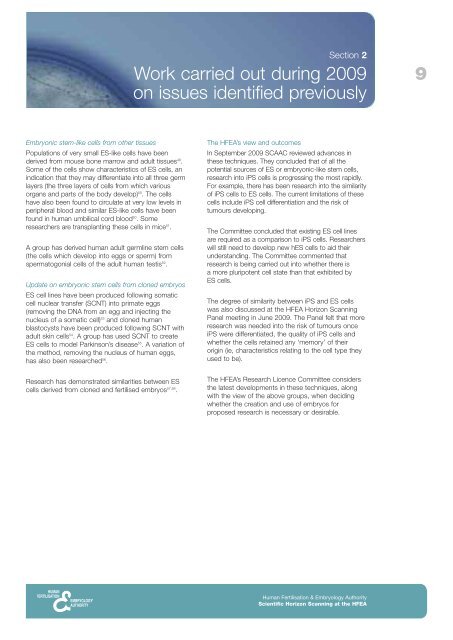Annual report 2009/10 - Human Fertilisation and Embryology Authority
Annual report 2009/10 - Human Fertilisation and Embryology Authority
Annual report 2009/10 - Human Fertilisation and Embryology Authority
You also want an ePaper? Increase the reach of your titles
YUMPU automatically turns print PDFs into web optimized ePapers that Google loves.
Section 2<br />
Work carried out during <strong>2009</strong><br />
on issues identified previously<br />
9<br />
Embryonic stem-like cells from other tissues<br />
Populations of very small ES-like cells have been<br />
derived from mouse bone marrow <strong>and</strong> adult tissues 49 .<br />
Some of the cells show characteristics of ES cells, an<br />
indication that they may differentiate into all three germ<br />
layers (the three layers of cells from which various<br />
organs <strong>and</strong> parts of the body develop) 50 . The cells<br />
have also been found to circulate at very low levels in<br />
peripheral blood <strong>and</strong> similar ES-like cells have been<br />
found in human umbilical cord blood 50 . Some<br />
researchers are transplanting these cells in mice 51 .<br />
A group has derived human adult germline stem cells<br />
(the cells which develop into eggs or sperm) from<br />
spermatogonial cells of the adult human testis 52 .<br />
Update on embryonic stem cells from cloned embryos<br />
ES cell lines have been produced following somatic<br />
cell nuclear transfer (SCNT) into primate eggs<br />
(removing the DNA from an egg <strong>and</strong> injecting the<br />
nucleus of a somatic cell) 53 <strong>and</strong> cloned human<br />
blastocysts have been produced following SCNT with<br />
adult skin cells 54 . A group has used SCNT to create<br />
ES cells to model Parkinson’s disease 55 . A variation of<br />
the method, removing the nucleus of human eggs,<br />
has also been researched 56 .<br />
Research has demonstrated similarities between ES<br />
cells derived from cloned <strong>and</strong> fertilised embryos 57,58 .<br />
The HFEA’s view <strong>and</strong> outcomes<br />
In September <strong>2009</strong> SCAAC reviewed advances in<br />
these techniques. They concluded that of all the<br />
potential sources of ES or embryonic-like stem cells,<br />
research into iPS cells is progressing the most rapidly.<br />
For example, there has been research into the similarity<br />
of iPS cells to ES cells. The current limitations of these<br />
cells include iPS cell differentiation <strong>and</strong> the risk of<br />
tumours developing.<br />
The Committee concluded that existing ES cell lines<br />
are required as a comparison to iPS cells. Researchers<br />
will still need to develop new hES cells to aid their<br />
underst<strong>and</strong>ing. The Committee commented that<br />
research is being carried out into whether there is<br />
a more pluripotent cell state than that exhibited by<br />
ES cells.<br />
The degree of similarity between iPS <strong>and</strong> ES cells<br />
was also discussed at the HFEA Horizon Scanning<br />
Panel meeting in June <strong>2009</strong>. The Panel felt that more<br />
research was needed into the risk of tumours once<br />
iPS were differentiated, the quality of iPS cells <strong>and</strong><br />
whether the cells retained any ‘memory’ of their<br />
origin (ie, characteristics relating to the cell type they<br />
used to be).<br />
The HFEA’s Research Licence Committee considers<br />
the latest developments in these techniques, along<br />
with the view of the above groups, when deciding<br />
whether the creation <strong>and</strong> use of embryos for<br />
proposed research is necessary or desirable.<br />
<strong>Human</strong> <strong>Fertilisation</strong> & <strong>Embryology</strong> <strong>Authority</strong><br />
Scientific Horizon Scanning at the HFEA

















